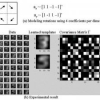Free Online Productivity Tools
i2Speak
i2Symbol
i2OCR
iTex2Img
iWeb2Print
iWeb2Shot
i2Type
iPdf2Split
iPdf2Merge
i2Bopomofo
i2Arabic
i2Style
i2Image
i2PDF
iLatex2Rtf
Sci2ools
ICCV
2001
IEEE
2001
IEEE
Separating Appearance from Deformation
By representing images and image prototypes by linear subspaces spanned by "tangent vectors" (derivatives of an image with respect to translation, rotation, etc.), impressive invariance to known types of uniform distortion can be built into feedforward discriminators. We describe a new probability model that can jointly cluster data and learn mixtures of nonuniform, smooth deformation fields. Our fields are based on low-frequency wavelets, so they use very few parameters to model a wide range of smooth deformations (unlike, e.g., factor analysis, which uses a large number of parameters to model deformations). In spirit, our ideas are most similar to the idea of separating content from style published by Tenenbaum and Freeman. However, our models do not need labeled data for training, and thus allow for unsupervised separation of appearance from deformation. We give results on handwritten digit recognition and face recognition.
Computer Vision | Handwritten Digit Recognition | ICCV 2001 | Impressive Invariance | Low-frequency Wavelets | Smooth Deformation Fields | Smooth Deformations |
| Added | 15 Oct 2009 |
| Updated | 31 Oct 2009 |
| Type | Conference |
| Year | 2001 |
| Where | ICCV |
| Authors | Nebojsa Jojic, Patrice Simard, Brendan J. Frey, David Heckerman |
Comments (0)

